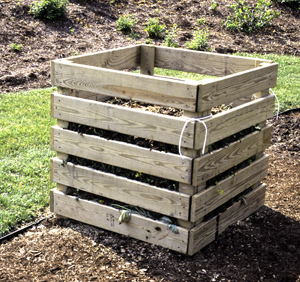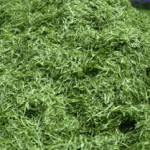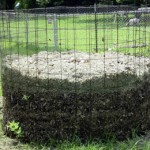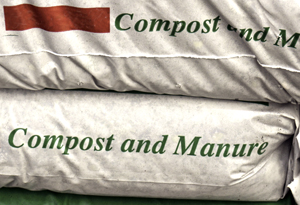 Whenever I teach a class on backyard composting, I always started out by saying, “All you have to do is throw your yard waste into a pile back in the corner of your lot and it will compost. Nature will eventually take care of it for you. Any questions?”. The students usually look at each other and wonder what the heck that means.
Whenever I teach a class on backyard composting, I always started out by saying, “All you have to do is throw your yard waste into a pile back in the corner of your lot and it will compost. Nature will eventually take care of it for you. Any questions?”. The students usually look at each other and wonder what the heck that means.
However, it is the truth that once something dies, nature starts to compost it. When we talk about “composting”, we are really talking about intervening in the process to make it go faster. Sure, you could just pile the stuff up and let it go but, depending on the types of plant material you have, it could take 5 or more years before it turns into a useable product. Most of us do not have enough room to have numerous piles of leaves and cuttings slowly decomposing. We would soon have no room for our beloved plants!
So, even though the basic process is the same, we humans can put it into high gear. Active composting is, in effect, just farming micro- and a few macro-organisms. They do all the work by eating the complex molecules in the leaves, stems and other plant parts and then running them through their tiny digestive systems. What comes out the other end are much simpler compounds and basic elements.
To be a good “farmer”, you need to provide the conditions that are required for your “livestock” i.e. micro and macro organisms to grow best. Be aware that there are two basic classifications of these organisms; aerobic and anaerobic. Aerobic critters need a good supply of oxygen to survive while anaerobic ones can get by on very, very small amounts. Both will eventually do the job of composting. However, the one thing you need to remember is that aerobic equals “smells good” while anaerobic equals “smells bad”. This is due to the types of gas each group produces while they are breaking down the organic matter.
Here are the keys to ensuring that your compost pile encourages only aerobic decomposers:
 A. Oxygen – Keeping the pile light and airy is important. That is why composting bins have holes or wire fencing all around the outside…to let in the air. It is also why you need to disturb i.e. turn the pile periodically to keep the oxygen mixed in.
A. Oxygen – Keeping the pile light and airy is important. That is why composting bins have holes or wire fencing all around the outside…to let in the air. It is also why you need to disturb i.e. turn the pile periodically to keep the oxygen mixed in.
B. Water – Like all (at least as far as I know) living organisms, decomposers need water. The key here is to keep the compost pile moist but not WATERLOGGED. Too little water and both the good and bad critters die. Too much water and only the good i.e. aerobic, organisms die, leaving only the stinky anaerobic decomposers.
C. Energy Source – Decomposers use organic matter as their energy source. For best growth, they need a certain amount of carbon (C) and a certain level of nitrogen (N).  Carbon sources are generally represented by brown stuff like autumn leaves while nitrogen comes from the green like grass clippings (although you should NOT be collecting those…more on that in another post).
Carbon sources are generally represented by brown stuff like autumn leaves while nitrogen comes from the green like grass clippings (although you should NOT be collecting those…more on that in another post).
You will often see a C to N ratio of around 30:1 that is best for ideal composting. If the pile has too much C, the process will be extremely slow or stop all together. If there is too much N, the process will often go anaerobic and begin to smell.
D. Heat – As the decomposers do their work, they give off some of the energy as heat. The warmer the pile, the faster the compost will be completed. The better the balance of oxygen, water and C:N ratio, the warmer the pile.
E. Particle Size – The smaller the size of the organic matter used in the pile, the faster the compost will be completed. An entire oak leaf has a certain amount of surface area where the micro-organisms can be feeding. If you chop that oak leaf into hundreds of littler pieces, the surface area available increases dramatically. That is why people buy chipper-shredders during the fall. These machines will take 8 bushels of leaves and, by shredding, turn them into about one bushel of material. This greatly decreases the amount of space you need to devote to composting.
 F. Volume – You need to have a proper volume of material for the process to work quickly. Spreading a couple of inches of organic matter on the ground is not enough volume. The heat from the micro-organisms will disperse too fast and the water will evaporate too quickly. If the pile is too large, oxygen will not be able to penetrate. So, for the backyard compost pile, you need a volume of about 3-4 feet high by 3-4 feet wide by 3-4 feet deep.
F. Volume – You need to have a proper volume of material for the process to work quickly. Spreading a couple of inches of organic matter on the ground is not enough volume. The heat from the micro-organisms will disperse too fast and the water will evaporate too quickly. If the pile is too large, oxygen will not be able to penetrate. So, for the backyard compost pile, you need a volume of about 3-4 feet high by 3-4 feet wide by 3-4 feet deep.
 Finally, how do you know when the compost is “finished”? The best answer seems to be, “When you can’t tell what it was before.” A bag of composted cow manure bears no resemblance to the what came from the barnyard.
Finally, how do you know when the compost is “finished”? The best answer seems to be, “When you can’t tell what it was before.” A bag of composted cow manure bears no resemblance to the what came from the barnyard.
